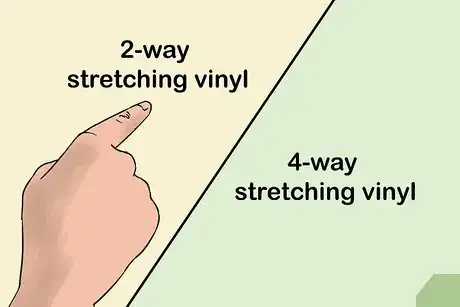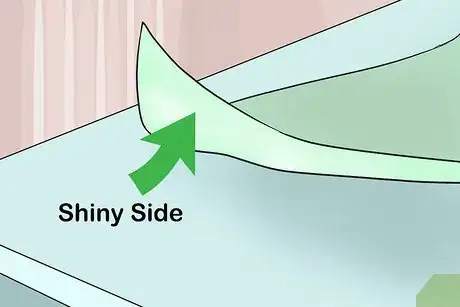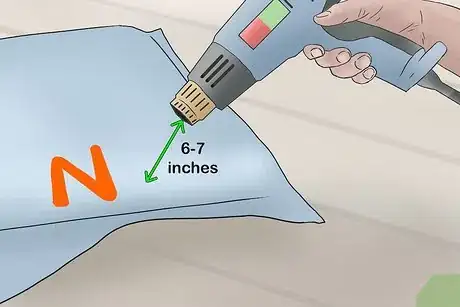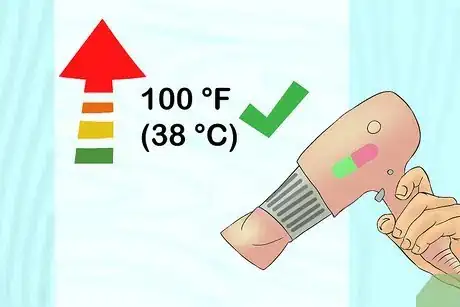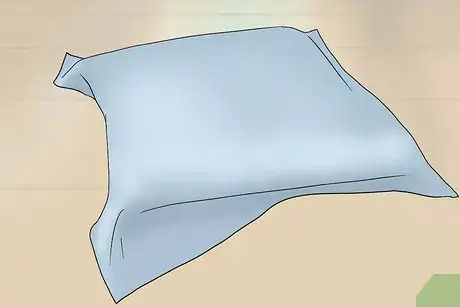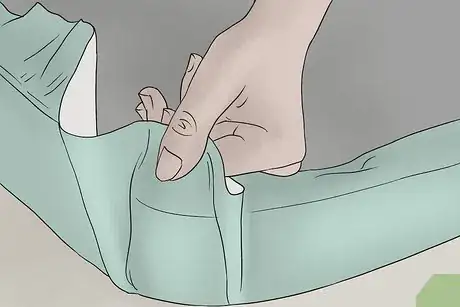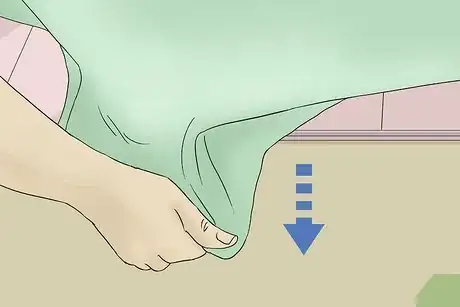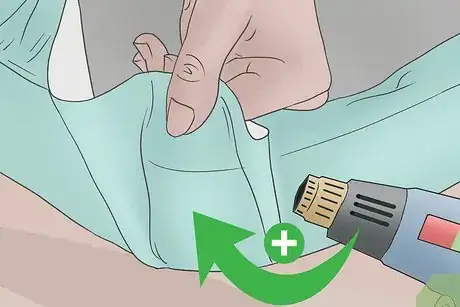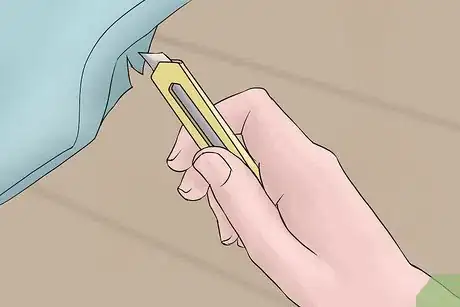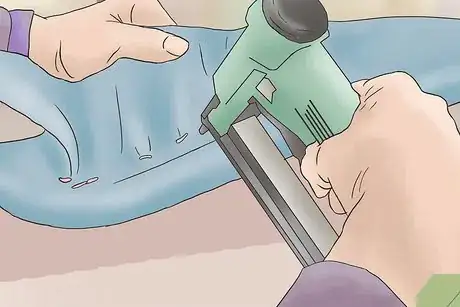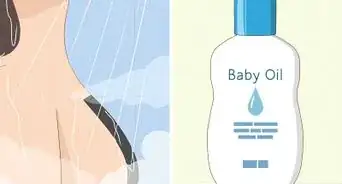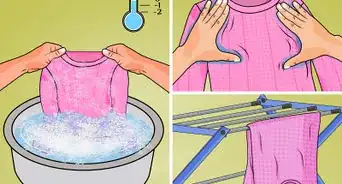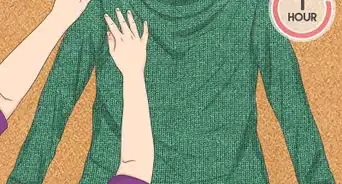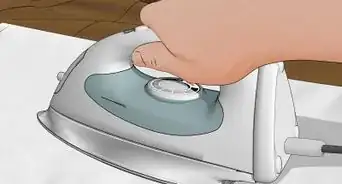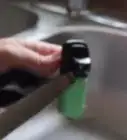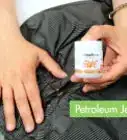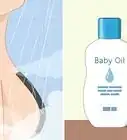This article was co-authored by Jordan Stolch. Jordan Stolch is an Image Strategist, Style Advisor, and the Founder of MiKADO - a concierge personal styling firm. With over a decade of experience, Jordan specializes in helping people eliminate the confusion and insecurities associated with how to dress in order to build a powerful image and use clothing to their strategic advantage. Jordan trains entrepreneurs, business leaders, and corporate executives in the foundations of "power dressing", from some of the country's preeminent companies such as Morgan Stanley, Deloitte, Berkshire Hathaway, Universal Music Group, Starbucks, and Disney. She works with clients both in-person and virtually, teaching them how to take the confusion out of style so they can operate at a higher level. Jordan earned her BA in Psychology from the University of Waterloo and studied Merchandise Marketing at the Fashion Institute of Technology (FIDM).
This article has been viewed 36,192 times.
Vinyl is a type of sleek, glossy fabric commonly used in furniture upholstery and fashion design. Though vinyl is normally quite stiff, you can use a heat gun to stretch out certain versions of the material.
Things You Should Know
- Vinyl fabric is not designed to stretch normally, but 2-way and 4-way vinyl is capable of being stretched (2-way from left to right, and 4-way in any direction).
- You will likely need to pin the vinyl in place when you’re stretching it out to keep it from snapping back into its original shape.
- Use a heat gun set to the lowest setting available to gently heat the vinyl once you’ve stretched it over the surface you’re covering.
- You do not have to heat the vinyl at all if you don’t want an airtight fit against the surface you’re covering.
- If you’re reupholstering something, use a staple gun to secure the vinyl to the surface that you’re covering with your vinyl.
Steps
Heating the Vinyl
-
1Acquire 2-way or 4-way stretching vinyl. Not all types of vinyl fabric have stretching capabilities. If you plan on expanding your fabric, make sure you purchase 1 of the following vinyl variants from a specialty fabric store:
- Two-way vinyl, which only stretches from left to right but is thicker and far more durable than 4-way vinyl.
- Four-way vinyl, which stretches both vertically and horizontally but is far thinner than 2-way vinyl, making it more susceptible to tears.
-
2Place your vinyl facedown on a firm surface. Find a flat, clean table or working surface that has enough space for your vinyl. Then, lay the fabric on top of the table with the shiny side facing down.
- If you’re stretching out vinyl clothing, see if you can unzip the garment and lay it out flat. If you can’t, simply place it on the table as is.
Advertisement -
3Turn on a heat gun and set it to high. To successfully stretch a piece of vinyl, you’ll need to heat the fabric to incredibly hot temperatures. This is best accomplished by using a handheld heat gun turned to its hottest temperature setting.[1]
- You can find heat guns at most home improvement stores.
- Check your heat gun’s instruction manual for information on how to change its temperature setting.
- If you don’t have a heat gun, you can use a standard hair dryer turned to its hottest setting instead.
-
4Hold the gun 7 in (18 cm) above the fabric and move it in a Z pattern. Place your heat gun or hair dryer 6 to 8 in (15 to 20 cm) above the fabric. Then, move it over the vinyl in a Z pattern to heat the material up. Make sure you keep the gun moving to avoid burning the vinyl.[2]
- Tilt the Z after every pass to heat the fabric evenly.
- For the best results, heat your fabric in 1 sq ft (930 cm2) increments.
- If a part of your vinyl isn’t heating up as quickly as the surrounding fabric, move the gun close to, but not touching, it for about half a second.
-
5Heat the fabric until it is about 100 °F (38 °C). In most cases, vinyl is ready to stretch when it is between 90 and 110 °F (32 and 43 °C), or almost hot enough to burn your hands. The heating process will normally take between 1 and 3 minutes, though the exact amount of time will depend on how powerful your heat gun or hair dryer is.[3]
- You can use a surface thermometer to find the temperature of your vinyl fabric.
Expanding the Fabric
-
1Place your vinyl over the object you're upholstering, if applicable. If you want to make your fabric a particular size, place the vinyl over an object that’s as large as you want it to be. If you’re stretching vinyl out for a specific reason, such as to reupholster a piece of furniture, place the fabric on top of the object in question.[4]
- If you’d like, you can place your vinyl over the object in question before heating it up.
-
2Stretch the vinyl between your hands. To stretch out your vinyl, grab 1 end of the fabric with your fingers and slowly pull it toward yourself. If you’re working with firm 2-way vinyl, feel free to use a lot of force while pulling. If you’re stretching thin 4-way vinyl, pull carefully to avoid tearing the fabric.[5]
- If necessary, hold the other side of the vinyl down with a bar clamp or ask a friend to keep it in place.
-
3Press down on the fabric to remove wrinkles. As your vinyl stretches, it may develop small, unappealing wrinkles. To remove these, simply press down on the fabric with your fingers and smooth them out.[6]
- If you’re stretching the vinyl over a specific object, make sure to press out any creases or air bubbles that form.
-
4Apply additional heat if the fabric stops stretching. Over time, your vinyl will cool down and become harder to manipulate. If this happens while you’re stretching it out, grab your heat gun and run it over the material again.[7]
- Do not press your heat gun to the vinyl fabric. If you do, you may damage the vinyl itself as well as the material underneath.
-
5Make non-visible cuts along the edges of the fabric if you overstretch it. If your vinyl starts to overstretch, make small incisions along the edges of the fabric with a pair of scissors or a precision knife. This will give you the ability to pull on 1 portion of the fabric without affecting the other parts.[8]
- Only use this technique on pieces of fabric where the edges won’t be visible, such as vinyl upholstery.
- If you’re pulling the vinyl around an object with curves, you may need to cut the fabric to help it better fit the object’s shape.
-
6Secure the fabric with staples if necessary. If you’re using your vinyl to reupholster an object, you’ll need to secure the material to keep it from peeling off. To do so, pull the fabric as tight as you can and hold it down to the object. Then, use a staple gun to shoot staples into the vinyl fabric.[9]
- Place staples between 1 and 2 in (2.5 and 5.1 cm) apart around the entire perimeter of the object. When finished, you should have a long line of evenly spaced staples.
- If necessary, ask a friend to hold the fabric down or use a bar clamp to keep it in place while you staple it.
Expert Q&A
-
QuestionWhat precautions do you need to take when stretching vinyl clothing?
 Jordan StolchJordan Stolch is an Image Strategist, Style Advisor, and the Founder of MiKADO - a concierge personal styling firm. With over a decade of experience, Jordan specializes in helping people eliminate the confusion and insecurities associated with how to dress in order to build a powerful image and use clothing to their strategic advantage. Jordan trains entrepreneurs, business leaders, and corporate executives in the foundations of "power dressing", from some of the country's preeminent companies such as Morgan Stanley, Deloitte, Berkshire Hathaway, Universal Music Group, Starbucks, and Disney. She works with clients both in-person and virtually, teaching them how to take the confusion out of style so they can operate at a higher level. Jordan earned her BA in Psychology from the University of Waterloo and studied Merchandise Marketing at the Fashion Institute of Technology (FIDM).
Jordan StolchJordan Stolch is an Image Strategist, Style Advisor, and the Founder of MiKADO - a concierge personal styling firm. With over a decade of experience, Jordan specializes in helping people eliminate the confusion and insecurities associated with how to dress in order to build a powerful image and use clothing to their strategic advantage. Jordan trains entrepreneurs, business leaders, and corporate executives in the foundations of "power dressing", from some of the country's preeminent companies such as Morgan Stanley, Deloitte, Berkshire Hathaway, Universal Music Group, Starbucks, and Disney. She works with clients both in-person and virtually, teaching them how to take the confusion out of style so they can operate at a higher level. Jordan earned her BA in Psychology from the University of Waterloo and studied Merchandise Marketing at the Fashion Institute of Technology (FIDM).
Image Consultant & Style Advisor In order to use heat to stretch it, the clothing needs to be the kind of vinyl that has a non-vinyl backing. If both sides are vinyl, then it will melt when exposed to heat. Then blow heat on it from the back, non-vinyl side, rather than on the front, vinyl side, and it won't melt.
In order to use heat to stretch it, the clothing needs to be the kind of vinyl that has a non-vinyl backing. If both sides are vinyl, then it will melt when exposed to heat. Then blow heat on it from the back, non-vinyl side, rather than on the front, vinyl side, and it won't melt.
Warnings
- When using a heat gun, make sure to wear safety goggles to protect your eyes. If you have long hair, tie it back to keep it away from the gun’s air duct.⧼thumbs_response⧽
Things You’ll Need
- 2-way or 4-way stretch vinyl fabric
- Heat gun or hair dryer
- Precision knife or scissors
- Staple gun and staples (optional)
References
- ↑ http://www.upholsteryresource.com/node/149
- ↑ http://www.upholsteryresource.com/node/149
- ↑ http://www.upholsteryresource.com/node/149
- ↑ http://www.upholsteryresource.com/node/149
- ↑ https://www.youtube.com/watch?v=sANLPfZ9BSY&feature=youtu.be&t=21m42s
- ↑ https://www.youtube.com/watch?v=jHC42qslVxQ&feature=youtu.be&t=12s
- ↑ https://www.youtube.com/watch?v=jHC42qslVxQ&feature=youtu.be&t=5s
- ↑ https://www.youtube.com/watch?v=jHC42qslVxQ&feature=youtu.be&t=2m13s
- ↑ http://cyberseams.com/article/104872/basics/working_with_vinyl_fabric_for_upholstery_and_apparel.html
About This Article
To stretch out a piece of vinyl fabric, first place the material facedown on a smooth working surface. Then, hold a heat gun 6 to 8 inches above the fabric and use it to warm the material for 1 to 3 minutes. Monitor the vinyl with a surface thermometer and, when it is about 100 °F, turn off the heat and pull the fabric toward yourself to stretch it. For tips on how to choose the right kind of vinyl, or to learn how to use vinyl fabric to reupholster a piece of furniture, read on!
